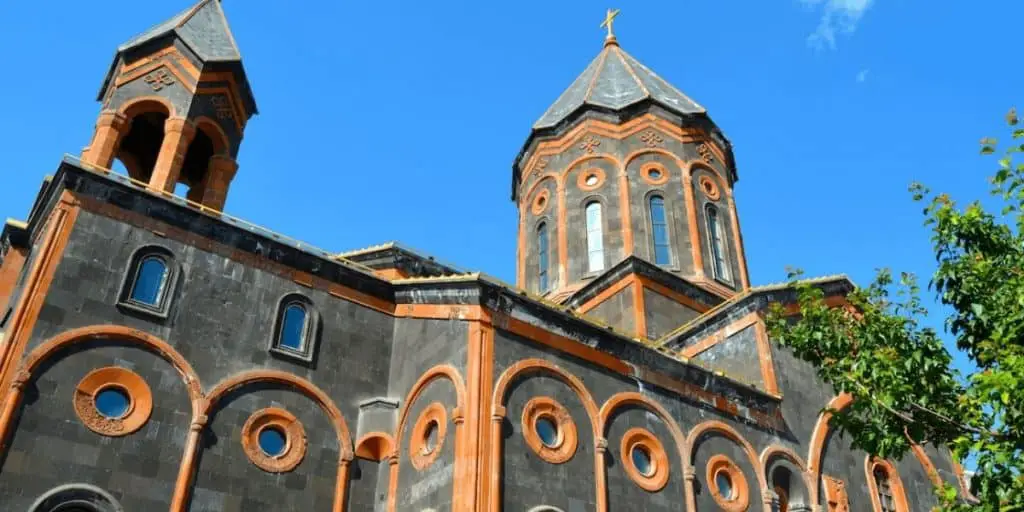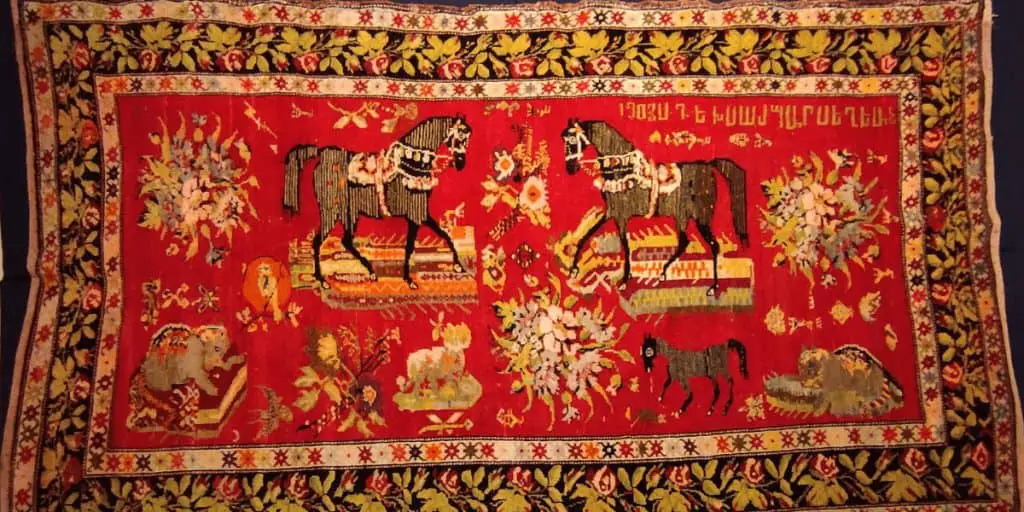In June 2016, Pope Francis visited Armenia and they called this trip a “Visit to the first Christian nation”. Is it true that Armenia was the first country to adopt Christianity on a state level? If you have some doubts, keep on reading this post. We will talk about the history and developments around the religion of Armenians and shed light on how Armenians became Christian.
Christianity became the state religion of ancient Armenia in 301 AD. The first advocates of the Christian faith in Armenia were Saint Apostles Thaddeus and Bartholomew. The tradition calls them the founders of the Armenian church which is now called the Armenian Apostolic Church. Armenians were converted to Christianity by King Tiridates and Saint Gregory the Illuminator.
So, let’s break it down a bit more in detail, and learn how Armenia became the first Christian state. If you want to share some ideas, please ping me on Twitter or Instagram with #ArmeniaTravelTips. I love hearing from you!
Armenian religion before Christianity
Ancient Armenians were Pagans, practicing a form of Zoroastrianism. They prayed to several gods just like the Greeks. The main god was called Ar (or Ara), the embodiment of the sun (Arev or Areg). That’s why the ancient Armenians called themselves “children of the sun”. There were other gods like Astghik, the god of beauty and love; Vahagn, the god of war, Tir (the god of writing) and many others. We remember and love our ancient gods. Even today’s Armenian New Year traditions have some pagan elements.
Armenia experienced proliferation and an age of victories during Paganism. However, Paganism and its relics were almost completely erased from our culture, our lands, and our minds when Christianity came. So, today, we have very little evidence of our Pagan past. One of the only reminders of it is the Temple of Garni. To learn more about it, check out my post about historical sights in Armenia.
Modern Paganism in Armenia
That being said, I want to mention Hetanism, a neo-Pagan movement in Armenia, which started at the end of the 20th century after the collapse of the Soviet Union. Contemporary Armenian Pagans believe that forced conversion to Christianity has led to us losing the connection with our ancestral strength. And given our troubling history as Christians, I think it’s understandable that we may have a movement today that calls for a return to our ancient roots.
Today, Armenian Pagans are very small in numbers (a little over 5000 people according to the 2011 census). However, they have an organized community, and they are even have their official registration at the Armenian state as a religious organization. They call their holy book Ukhtagirk. The literal translation is the “Book of Vows”. Slak Kakosyan wrote the book. However, he doesn’t take the credit as the “author” of the Ukhtagirk, but rather as the “recorder” of eternal truth.
Adoption of Christianity and the Armenian monarchy
The tradition says that Christianity was established as the official religion of ancient Armenia thanks to Saint Gregory the Illuminator. He is known as Grigor Lusavorich. According to records, and namely, by the texts of Agathangelos, Gregory converted king Tiridates the Great to the new religion, formally establishing the Armenian Church, and spreading Christianity throughout the country.
According to legend, Gregory the Illuminator did not want to take part in pagan rituals although he had a position in the royal palace. The reigning monarch at the time, Tiridates the Great, wasn’t too happy about that and he threw Gregory the Illuminator into a dungeon in Khor Virap, where the “rebellious” Christian had to spend 14 years.
However, King Tiridates got very ill at some point, and his sister saw in her dream that only Gregory could save the king. According to the legend, Tiridates then ordered to release Gregory, who cured him. Impressed by the “magical” cure the king agreed to convert to Christianity. Once Gregory converted the king, the king himself forced Armenians all over the country to convert to Christianity as well.
We don’t know when exactly this happened. The accepted view is that the Armenian monarchy adopted Christianity in 301 AD, there are some conflicting views in the ancient records. Some sources state the year 314 CE as the date of Armenia’s official adoption of Christianity. What’s sure is that the ruling elite forced Christian faith upon my people at large sometime in the early 4th century.
Was it good? Was it bad? Let’s look at the role that the adoption of Christianity played in Armenian society.
Reasons and consequences of the adoption of Christianity in Armenia
While the legend about the miraculous cure sounds nice, the conversion of Armenians to Christianity could have been a well-calculated political move at the time, if you ask me. The 3rd century was a very chaotic time for Armenia’s statehood. Our lands switched hands dozens of times in the battles between the Roman Empire, Parthians, and Persians. Betrayal was also a pretty common event among the elites. And I’m sure King Tiridates was well aware of this history and the risks present in the region.
While the majority of Armenians in the early 4th century still practiced Paganism, Christianity was quickly gaining in popularity among them, as well as across the whole Byzantine Empire. Moreover, it seems like both the Roman Empire and the Persians were becoming more favorable towards Christianity. So, converting the country to Christianity could have been a popular move by Tiridates, and a creative solution for balancing the interests of powerful neighbors.
New identity
Another key aspect here, I think, is that establishing a distinct identity among his people could have strengthened his position as that a ruler. So, conversion to Christianity could be one of the tools for building the Armenian identity under one ruler and one god. And in fact, it worked. Christian identity is in many ways inseparable from the Armenian identity for many Armenians to this day.
What was important here was that all social groups had to adopt the new identity, i.e. the new religion. However, rural peasants were probably more likely to remain faithful to the “old gods”, which could have put Tiridates’ plans into jeopardy. So, forceful conversion to Christianity was probably the way to go in his eyes.
In the upcoming decades and centuries, Armenian Christianity and the Church in particular would become key drivers of the development of distinct Armenian culture, language, rituals, and practices. These united Armenians, while simultaneously separating their identity from the other communities of the region. The creation of a strong educational and cultural system, which people would accept, yet protected from foreign influence, was instrumental in state building.
The creation of the Armenian alphabet further reinforced the adoption of Christianity. That was the reason why Mesrop Mashtots took the task to create it in 405, and immediately after that, he set to the translation of the Bible into Armenian. It they became popular among rural peasants. Btw, I have a cool write-up about the Armenian alphabet, its history, and misconceptions. So, check it out to learn more.
How did the Armenian church gain independence?
The Armenian Church proclaimed its autonomy in the early fifth century after the Council of Chalcedon (451). The main difference between the Armenian and Catholic churches was that the Catholic Church established the dual nature of Jesus Christ – human and divine. On the other hand, the Armenian Church believes in monophysitism (one nature). Some may say this is silly if you consider that it’s the main reason for splitting a whole religion. Which makes me believe this might have been yet another political move.
Since then, the Armenian Church has been independent. We call it Apostolic since it traces its origins to the two apostles (out of 12) Thaddaeus and Bartholomew, preaching Christianity to regular Armenians before it became our state religion. Our Church maintains good relations in an ecumenical spirit with the Orthodox, Catholic, and Protestant Churches, and has its own leader, the Catholicos, entirely independent of the ecclesiastical hierarchies of the other confessions.
Concluding our switch to Christianity
Being an atheist myself, I should give credit to the role of Christianity in Armenian society. It was probably necessary to have a separate identity, strengthen the role of the state and have a unified church back when the elite made the decision to convert the nation to Christianity. As of today, 97% of Armenians consider themselves followers of the Armenian Apostolic Church. Although not very religious (few attend masses on a regular basis), they identify their faith with the Apostolic Church.
So, this is how Armenians became Christian. You can also read about how Armenians remained Christian despite of the fact that powerful Muslim states surrounded the country. Also, if you want to know some interesting facts about Armenian culture check out that link. I’m sure you’ll find a couple of points quite curious. And If you want to share some of your thoughts on our culture with me, please ping me on Twitter or Instagram with #ArmeniaTravelTips.
Featured image credit: Photo by Robert Levonyan on Unsplash
Please help me make Armenia more popular!






